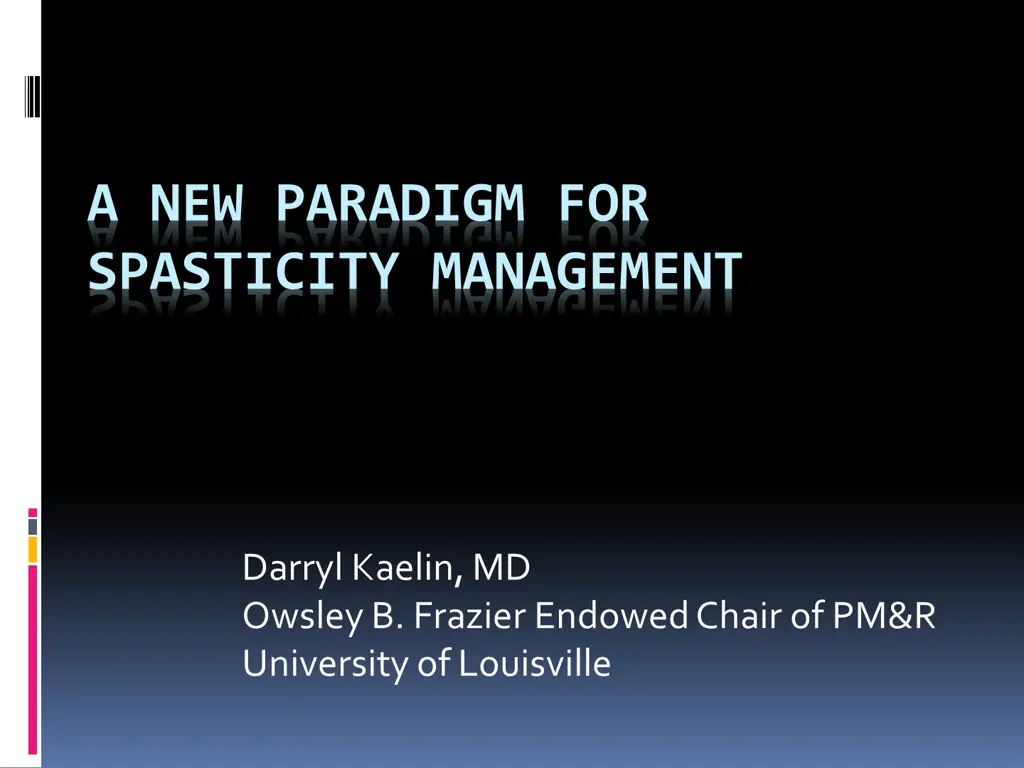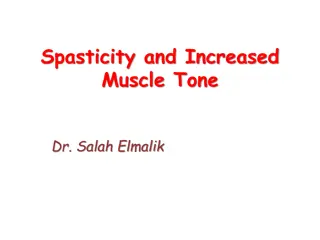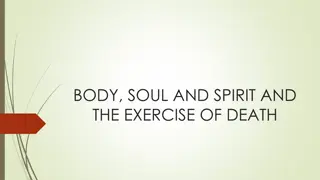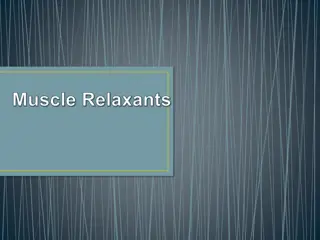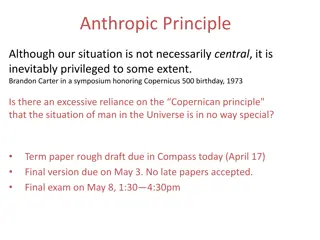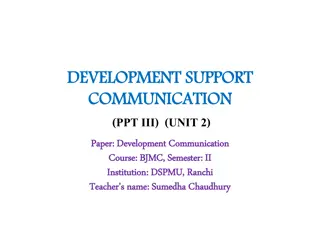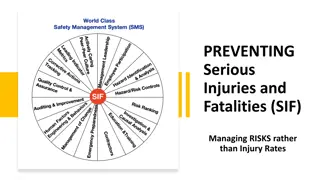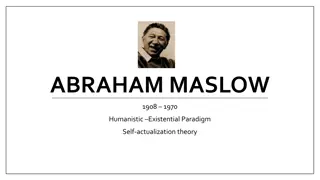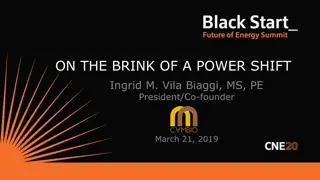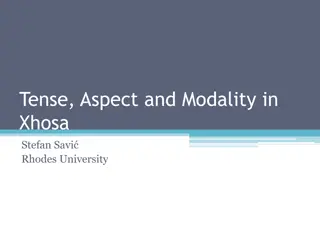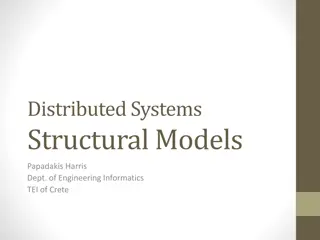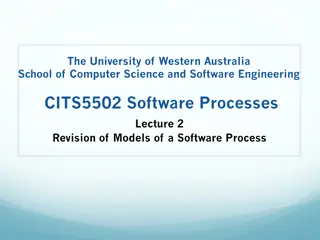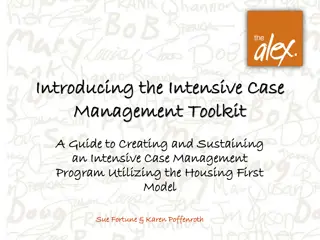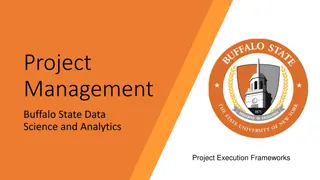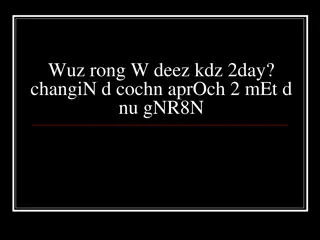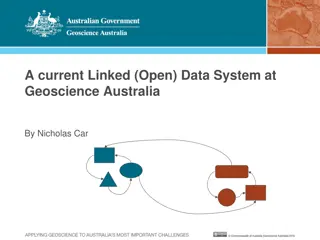A New Paradigm for Spasticity Management
New approach to managing spasticity, a disorder characterized by increased muscle tone and exaggerated tendon jerks. The author, Dr. Darryl Kaelin, explores the benefits of this new paradigm and its potential impact on motor control. The article also includes information on the etiologies and prevalence of spasticity, as well as the differences between passive and active assessments.
- spasticity management
- motor control
- sensorimotor system
- muscle tone
- tendon jerks
- etiologies
- prevalence
- passive assessment
- active assessment
- UMN syndrome
Download Presentation

Please find below an Image/Link to download the presentation.
The content on the website is provided AS IS for your information and personal use only. It may not be sold, licensed, or shared on other websites without obtaining consent from the author. Download presentation by click this link. If you encounter any issues during the download, it is possible that the publisher has removed the file from their server.
E N D
Presentation Transcript
A NEW PARADIGM FOR SPASTICITY MANAGEMENT Darryl Kaelin, MD Owsley B. Frazier Endowed Chair of PM&R University of Louisville
Disclosures Allergan Speakers Bureau / Advisory Board Ipsen Research Medtronic Speakers Bureau / Research NIDRR Grant Best Doctors Inc. -Consultant
Definition of Spasticity Spasticity is a disorder of the sensorimotor system characterized by a velocity-dependent increase in muscle tone with exaggerated tendon jerks, resulting from hyperexcitability of the stretch reflex. Lance. Spasticity: Disordered Motor Control. 1980.
Etiologies Stroke Cerebral palsy Multiple sclerosis Traumatic brain injury Spinal cord injury Anoxia Neurodegenerative disease Others Gormley. Muscle Nerve. 1997;20:S14.
Approximate Prevalence of Spasticity by Diagnosis (U.S.) Diagnosis Prevalence 3,000,000 Stroke 1,2 350,000 Multiple sclerosis 3,4 250,000 Spinal cord injury 5,6 Traumatic brain injury7 2,500,000 500,000 Cerebral palsy 8 1. Watkins CL, et al. Clin Rehabil. 2002;16:515-522. 2. Somerfeld DK, et al. Stroke. 2004:35: 134-139. 3. Rizzo MA, et al. Mult Scler. 2004;10:589-595. 4. Mayr WT, et al. Neurology. 2003;61:1373-1377. 5. Walter JS, et al. J Rehabil Res Dev. 2002;39:53-61. 6. DeVivo MJ, et al. J Spinal Cord Med. 2002;25:335-338. 7. Tieves KS, et al. WMJ. 2005;104:22-25, 54. 8. Reddihough DS, et al. Aust J Physiother. 2003;49:7-12.
Passive vs Active Assessment There is a difference between the UMN lesion assessment in a resting state and the associated spastic movement disorder that people complain about. WHY? Increased MSR is only a small part of the reflexive mechanism involved in movement like gait. Spasticity is a compensatory mechanism that may help with function in the face of severe paresis. The clinical exam has historically focused on resting reflexive state not movement disorder. V. Dietz
UMN Syndrome: Common Clinical Phenomena Positive Spasticity Rigidity Tremor Clonus Dystonia Moberg-Wolff. eMedicine Journal. Available at www.emedicine.com.
UMN Syndrome: Common Clinical Phenomena Negative Weakness Slow motion capacity to generate optimal force Incoordination Loss of fine dexterity selective muscle control Moberg-Wolff. eMedicine Journal. Available at www.emedicine.com. Mayer. Muscle Nerve. 1997;20:S1.
Acute Delayed t CNS damage CNS plastic rearrangements Supraspinal Spinal Paralysis Immobilization in short position Disuse Muscle overactivity Soft tissue plastic rearrangements = Spasticity Spastic dystonia Spastic co-contraction Others Contracture Natural History of Spastic Paralysis Gracies JM. Muscle Nerve. 2005;31:535-551.
Overview of Spastic Muscle Overactivity Spasticity Increase in velocity-dependent muscle responses to stretch (present at rest) Spastic dystonia(often associated with spasticity) Tonic chronic involuntary muscle contraction; source of deformities and disfigurement (present at rest) Spastic co-contraction (often associated with spasticity) Involuntary recruitment of an antagonist during a voluntary effort on the agonist . Gracies JM. Muscle Nerve. 2005;31:535-551.
Assessment of Spasticity Spasticity problems can be characterized as focal, segmental, multisegmental, or generalized. Examples: Focal Hitchhiker s Toe Segmental Spastic flexor pattern in UE Multisegmental Spastic Hemiplegia Generalized Spastic Quadraparesis
Patient Evaluation Participation of patient/caregiver in Assessment of spasticity Basic Quality of Life Performance with ADL Level of support Life-style maintenance/improvement ADL=activities of daily living
Patient Evaluation (contd) Physical Examination Standard and consistent technique is important to obtain unbiased results Use a fixed evaluation sequence Provide consistency in outcome measurements Valid assessment measure Therapist Feedback
Patient Evaluation (contd) Motor Pattern Identification Diagnostic nerve block Dual-channel electromyography (DEMG) Dynamic EMG Quantitative gait analysis Kraft. Phys Med Rehab Clin North Am. 1999;4:687. Gitter. Available at http://www.vard.org/mono/gait/gitter.htm. Perry. Available at http://www.vard.org/mono/gait/perry.htm.
Functional Objectives Improve potential for therapeutic outcomes Improve mobility Improve ADL Maximize pain relief Decrease impact of hypertonicity on quality of life Improve range of motion (ROM) Improve tone Improve outcomes from the PT/OT Brin. Muscle Nerve. 1997;20:S208.
Management of Spastic Paresis Stretch and relaxation of the more overactive muscles - Stretch programs, serial casting, orthopedic surgery when conservative techniques are insufficient - Relaxation of overactive muscles - Focal agents (alcohol compounds, botulinumtoxins) Systemic agents (baclofen, tizanidine) Surgical destruction of overactive nerves Training of their antagonists: exercise programs
Oral Medications Commonly Used Adjunctive Rarely Used Benzodiazepines Gabapentin Cyproheptadine Dantrolene Clonidine Cannabinoids Baclofen Orphenadrine Tizanidine Gracies. Muscle Nerve. 1997;20:S92.
Chemodenervation and Neurolysis Injectable therapy Local muscle weakening Reversible (over time) Temporary Titratable to patient needs Agents Botulinum toxins Phenol Alcohol Gracies. Muscle Nerve. 1997;20:S92. Brin. Muscle Nerve. 1997;20:S208.
Botulinum Toxins Clinical Effects in Spasticity Direct injection in affected muscle(s) Therapeutic effect usually within 24 72 hours (BTX-A) Peak effect at 2 weeks (BTX-A) Duration of benefit ~ 12weeksmonotherapy May be used in combination with Oral medications Intrathecal baclofen Phenol/alcohol Brin. Muscle Nerve. 1997;20:S208. Brin. Neurology. 1999;53:1431. Brashear. Neurology. 1999;53:1439.
Nerve Blocks Short acting -Local Anesthetics Interfere with Na permeability Lidocaine Bupivicaine Etidocaine Long Acting Denaturing of axon Phenol (3-7% solution) Ethanol (25-100% solution) Risk of paresthesias may be overestimated Beckerman et al, 1996
Comparing BTX and Phenol Botulinum Toxin Phenol Indications (tone) Any type of tone Velocity-dependent mediated tone Titration of effect Dose dependent Dependent on number of motor branches Onset 24 72 h; peak at 21 28d Immediate Optimal location for injection Small muscles fine control Large muscles strength Duration of effect 3 to 5 months 4 14 months Local toxicity No irritation Potential edema, necrosis Systemic toxicity Rare If injected intravascular or intrathecal Brin. Muscle Nerve. 1997;20:S146, S208.
Intrathecal Baclofen Implantable, programmable pump For management of severe spasticity Gracies. Muscle Nerve. 1997;20:S92.
Intrathecal Baclofen Selection Criteria Clinically stable Failure of oral agents on adequate trial Intolerable side effects from alternative medications Significant muscle overactivity that affect mobility, ADLs, pain and burden to caregiver Not pregnant or nursing Meythaler. Stroke. 2001;32(9):2099.
Intrathecal Baclofen Potential Side Effects Side-effect profileis similar to oral medication with a much lower incidence Hypotonia Somnolence Nausea/vomiting Sedation Headaches Dizziness Potential complications related to device Catheter-related infection Pump dysfunction Programmer errors Gracies. Muscle Nerve. 1997;20:S92. Nance. Phys Med Rehab Clin N Am. 1999;10:385.
Surgical Modalities Orthopedic procedures Tendon transfers Musculotendinous lengthening Joint fusion surgery for stability Gracies. Muscle Nerve. 1997;20:S92.
Neurosurgery Mostly used in pediatric patients DREZotomy Microsurgical Dorsal Root Entry Zone lesion Indicated following failure of conservative options Conditions: spasticity, neurogenicand cancer pain Selective Dorsal Rhizotomy Sectioning of afferent nerve rootlets under EMG guidance Indicated for pure spasticity with minimal/no athetosis Good strength, motor and trunk control Contraindications Certain types of muscle weakness Hypotonia Lammertse. Available at http://www.thomasland.com.
Common Algorithm of Treatment
The New Paradigm AntispasticityTreatments (drugs, injections/blocks, surgery) are all studied based on their effects on passive assessment tools like reflex activity and Ashworth Scale, while what we are interested in is functional activity. Most studies measuring antispasticity treatments on function have found little improvement. WHY?
New Paradigm Functional activity is not affected by mono- synaptic reflex hyperexcitabilitybut rather by the long-latency reflex component. The spastic movement disorder is caused by reduced adaptation of muscle/CNS reactivity to ground forces together with reduced capacity to modulate reflex activity over the normal range of movement. SO??? V. Dietz
New Paradigm SO If we normalize somatosensory feedback to the CNS through appropriate passive, electrically stimulated and/or active- assisted movements of joints/limbs we will normalize CNS reorganization and recovery. Additionally, if the CNS (spinal cord) is modulated appropriately from the cortex then it will respond to forces and control volitional movements better. S. Harkema
Activity Based Therapy Activation to the neuromuscular system below the level of injury Focus on Recovery of Function vs. Compensation Primary Components include: 1. Repetition and Intensive Strengthening 2. Motor Patterned Activity 3. Functional Training/Task Specificity
Activity Dependent Neural Plasticity Lasting changes produced in the nervous or muscular systems that are driven by repetitive activity (Wolpawet. al 2001) Reorganization of pathways spared by the initial lesion Formation of new circuits through collateral sprouting of lesioned and unlesionedfibers Plasticity thought to be driven by: Sensory input Task specificity Repetitive practice ****Spasticity results from both disordered spinal mechanisms and disordered supraspinal mechanisms. (Sullivan and Schmitz, 1994)
Clinical Application of ABT Individual Program may include: Intensive Strengthening (often in combination with estim) Core strengthening sessions Resistance training for upper and lower extremities Plyometrictraining Motor Patterned Activity Giger FES bikes Manual locomotortraining (often in combination with estim) Robotic locomotortraining Functional training/Task Specificity Overgroundgait training with or without FES Upper extremity FES Mobility training Developentalsequencing
Physiological Mechanisms: Reciprocal Inhibition: Primary 1a Sensory Afferents Muscle stretch causes1a afferents to increase their firing rate Agonist and synergists contract in response Collateral interneurons activate 1a inhibitory neuron Results in relaxation of the antagonist Best response in submax range Pathway activated during voluntary and electrically stimulated contractions
Physiological Mechanisms: Recurrent Inhibition: Renshaw Cell Inhibitory interneuronslocated in the ventral horn 1 action potential (ap) in a motor neuron results in burst of ap sfrom Renshawcell Results in inhibition of motor neuron pool (agonist) by recurrent collaterals of alpha motor axons Prevents motor neuron from being fired too frequently Results in overall decreased agonist activity Activated during voluntary and electrically stimulated contractions
FES Training Algorithm 1. Assess general spasticity first TBI/CVA/SCI 2. Determine if appropriate in task specific practice 3. As patient continues to progress, discharge FES unilaterally when standard is met. Assess Spasticity Ability to step OG Manual Treadmill 4. Decision based on 2 out of 3 agreements unilaterally. Ability to take steps Over Ground Manual Treadmill Training Spasticity M. Ashworth 1 at hip/knee/ankle M. Ashworth>1 at hip/knee/ankle Step unilaterally Without assist Unilateral step Requires assist Good Heel strike No clonus stance Poor Heel strike Clonus in stance No FES FES No FES FES No FES FES
Summary: The New Paradigm is really a shift back to the basics (Activity Based Therapy). There is no Quick Fix drug, treatment or surgery for spasticity. Ultimately the site of the CNS lesion will determine which neural control mechanisms are deficient and what treatment may offer the best response. The best functional outcome may still be with some combination of interventions at various times in recovery.
